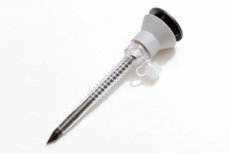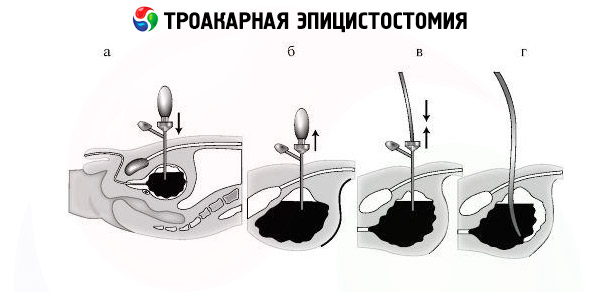Medical expert of the article
New publications
Epicystostomy of the bladder: indications, course of surgery, complications
Last reviewed: 04.07.2025

All iLive content is medically reviewed or fact checked to ensure as much factual accuracy as possible.
We have strict sourcing guidelines and only link to reputable media sites, academic research institutions and, whenever possible, medically peer reviewed studies. Note that the numbers in parentheses ([1], [2], etc.) are clickable links to these studies.
If you feel that any of our content is inaccurate, out-of-date, or otherwise questionable, please select it and press Ctrl + Enter.

In cases of disturbance of the physiological process of urination - in the absence of the possibility of emptying the patient's bladder by urethral catheterization - epicystostomy is performed. That is, bypassing the urethra, a special urinary system is installed through the abdominal wall directly into the bladder - epicystostomy, which works on the principle of drainage and can, unlike a ureteral catheter, be used for a long time.
Indications for the procedure
The list of main indications for suprapubic bladder drainage (epicystotomy) includes:
- ischuria – acute and chronic urinary retention in patients with hyperplasia (adenoma) of the prostate gland or adenocarcinoma; [ 1 ]
- disorders of the urination process in cases of traumatic damage to the urinary organs;
- condition after surgery, for example, removal of a urethral polyp, dilation of the sclerotic neck of the bladder or its transurethral resection;
- acute urological infections with obstruction of the urethra;
- dysfunction of the urinary organs in spinal cord injuries with the development of lower paraparesis or paralysis; [ 2 ], [ 3 ]
- urethral strictures due to bladder stones;
- severe cases of neurogenic bladder;
- congenital uropathies, such as infravesical obstruction syndrome.
The use of modified trocar epicystostomy in the surgical treatment of hypospadias in children is described. [ 4 ]
Preparation
If epicystostomy is planned, then its implementation is prescribed after the appropriate examination and all diagnostic procedures. In urgent cases - with acute ischuria - special preparation of the patient is not required, and all necessary studies are carried out after the installation of the cystostomy.
During this procedure, the appropriate instruments for epicystostomy are used: a sharp scalpel, surgical scissors and tweezers, syringes, and a trocar.
A specially equipped sterile kit for epicystostomy is used, consisting of a trocar, a catheter (Foley or Pezzer), a guide needle (introducer), a clamp, a skin fixator, and a urine bag. There are various modifications of such kits from different manufacturers.
Technique epicystostomies
Depending on the type of surgical intervention, the operation to create a stoma (artificial opening) can be performed as an open epicystostomy or as a less invasive trocar epicystostomy. [ 5 ]
In open epicystostomy, which requires long-term urinary drainage, epidural or general anesthesia is used and the technique of performing surgery with wide access to the bladder is used - with dissection of all layers of the peritoneum 50 mm below the navel in the vertical direction and its diversion, after which the surgeon pulls up the bladder and makes an incision on its wall, through which a drainage catheter is inserted into the bladder. After this, the incision in the bladder wall is sutured (simultaneously fixing the position of the catheter in the stoma) and the entire surgical wound.
Suprapubic cystostomy is a common procedure used to treat acute urinary retention after failed urethral catheterization and when long-term catheterization is needed. This procedure is more effective and has fewer complications than urethral catheterization or open epicystostomy. [ 6 ], [ 7 ]
When an epicystostomy of the bladder is required for a limited period of time, a suprapubic trocar epicystostomy is performed under local anesthesia. For this intervention to proceed normally, the bladder must be full, for which the patient is given a small amount of liquid before the operation. If this is not possible, the bladder is filled with air.

During this operation, the abdominal wall and the underlying urinary bladder are pierced with a trocar stylet 30 mm above the pubic bone, and a catheter is inserted into the small opening under ultrasound control through the trocar tube. [ 8 ] If a Foley catheter equipped with a balloon is used, the catheter is fixed inside the opening by inflating it. The trocar is then removed, and the drainage tube passing through the stoma is fixed to the surface of the skin.
An inguinal approach for placement of a cystostomy tube into the bladder with minimal soft tissue dissection is described.[ 9 ]
Contraindications to the procedure
Urologists consider the main contraindications for epicystostomy to be a malignant tumor of the bladder, acute inflammation of the ureter, abnormal localization of the bladder, dysfunction of its sphincters, the presence of a pelvic bone fracture in the patient, adhesions in the lower abdominal cavity, as well as a high degree of abdominal obesity and a significant decrease in blood clotting.
Complications after the procedure
Possible postoperative consequences include pain, skin irritation around the artificial fistula, suture divergence, bleeding, tissue infection at the site of catheter placement with the formation of purulent discharge and an increase in body temperature.
Complications following an epicystostomy procedure include:
- catheter falling out of the stoma or becoming blocked;
- urine leakage, as well as its entry into the intra-abdominal space;
- spasm of the bladder and urethra;
- hematuria; [ 10 ]
- secondary infection of the bladder through epicystoma with the development of cystitis; [ 11 ]
- A case of acute purulent cavernitis and prostatitis in a patient with diabetes mellitus after epicystostomy is described; [ 12 ]
- Bowel injury was reported to occur in 2.2% of patients.[ 13 ]
Care after the procedure
In the first week after the procedure, when a sterile gauze napkin is applied to the cystostomy area, antiseptic treatment of the skin is performed; subsequently, the use of water and soap will be sufficient.
Any actions to change the dressing and treat the catheter tube are carried out only with clean hands (in the first month - preferably with sterile gloves), since compliance with hygiene rules plays a very important role in preventing complications.
Each patient receives detailed instructions from the urologist on post-procedure care, in particular:
- the need for timely emptying of the urine bag and its weekly replacement;
- replacing the catheter itself every one to two months (depending on the type of catheter);
- regarding the correct wearing of the urine bag (fixing it below the level of the bladder - on the outer surface of the thigh, and at night - on the bed, below the position of the body).
People with epicystoma are advised to shower more often; limit alcohol consumption as much as possible and drink less strong tea, coffee and carbonated water, which can irritate the mucous membrane of the bladder. But to avoid stagnation, it is recommended to drink at least one and a half liters of clean water during the day.
Reviews
Reviews of some patients after this operation indicate the possibility of intense pain at the site of cystostomy, hyperemia and swelling of the skin, as well as the release of cloudy urine and the appearance of an unpleasant odor. With all problems associated with the transferred epicystostomy, you should immediately contact your urologist.

